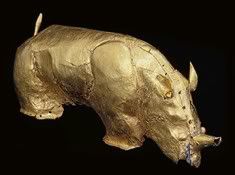Did You Know?
 One thousand years ago,Mapungubwe (present day South Africa) in Limpopo province was the centre of the largest kingdom in the subcontinent, where a highly sophisticated people traded gold and ivory with China, India and Egypt. The Golden Rhinoceros has a single horn, a physical trait of the Asian Rhinoceros, which gives further evidence of the peoples' trade with the East.
One thousand years ago,Mapungubwe (present day South Africa) in Limpopo province was the centre of the largest kingdom in the subcontinent, where a highly sophisticated people traded gold and ivory with China, India and Egypt. The Golden Rhinoceros has a single horn, a physical trait of the Asian Rhinoceros, which gives further evidence of the peoples' trade with the East.
Mapungubwe is an area of open savannah at the confluence of the Limpopo and Shashe Rivers and adjoining the northern border of South Africa and the borders of Zimbabwe and Botswana.
The site was discovered in 1932 and has been excavated by the University of Pretoria ever since. The findings were kept quiet at the time since they provided contrary evidence to the racist ideology of black inferiority that helped to sustain apartheid. The Iron Age site was hidden from public attention and until only recently, has been declared a World Heritage Site by the United Nations Educational, Scientific and Cultural Organisation (Unesco).
 Excavations revealed a court sheltered in a natural amphitheatre at the bottom of the hill, and at the top of the hill, a graveyard reserved for members of the social elite – with a spectacular view of the region. It was also discovered that the population kept domesticated animals like cattle, sheep, goats and dogs and were generally prosperous. Millet, sorghum and cotton were cultivated as well, as evidenced by the charred remains of storage huts that were found.
Excavations revealed a court sheltered in a natural amphitheatre at the bottom of the hill, and at the top of the hill, a graveyard reserved for members of the social elite – with a spectacular view of the region. It was also discovered that the population kept domesticated animals like cattle, sheep, goats and dogs and were generally prosperous. Millet, sorghum and cotton were cultivated as well, as evidenced by the charred remains of storage huts that were found.
Smiths created objects of iron, copper and gold for practical and decorative purposes – both for local use and for trade. Pottery, wood, ivory, bone, ostrich eggshells, and the shells of snails and freshwater mussels, are further indications that many other materials were used and traded with cultures as far away as East Africa, Persia, Egypt, India and China.
Mapungubwe's financial prosperity petered out somewhere between 1290-1300 AD. This was due to a change in trade routes however, and not climate change as was previously thought. This change in trade routes led to a shift in trade to Great Zimbabwe - another advanced society, located in the south-west of Zimbabwe and distinguished by great rock walls that were constructed seven centuries ago , and still stand despite no form of cement being used to bind them. Great Zimbabwe lasted until 1400 AD, at which time, the Portuguese colonized Mozambique and changed the trade routes again.
According to findings published by the University of Praetoria:"Twenty-three graves have been excavated from this hilltop site. Within three of these graves were corpses that were buried in the upright seated position usually associated with royalty, with a variety of gold and copper items, exotic glass beads, and other prestigious objects."Two noteworthy items are a golden sceptre and a golden bowl.
Other archeological treasures that were found were: beautifully decorated clay pots, wooden spoons, whistles, funnels, and spindle whorls used to spin the cotton they grew. Thousands of gold and glass beads were also found. The first communities who made iron tool and clay pots arrived in the central Limpopo valley during the early Iron Age, possibly by AD 500. These people were the forerunners of larger farming communities of the Iron Age who settled in the Limpopo River valley between AD 800 and AD 1400.

No comments:
Post a Comment